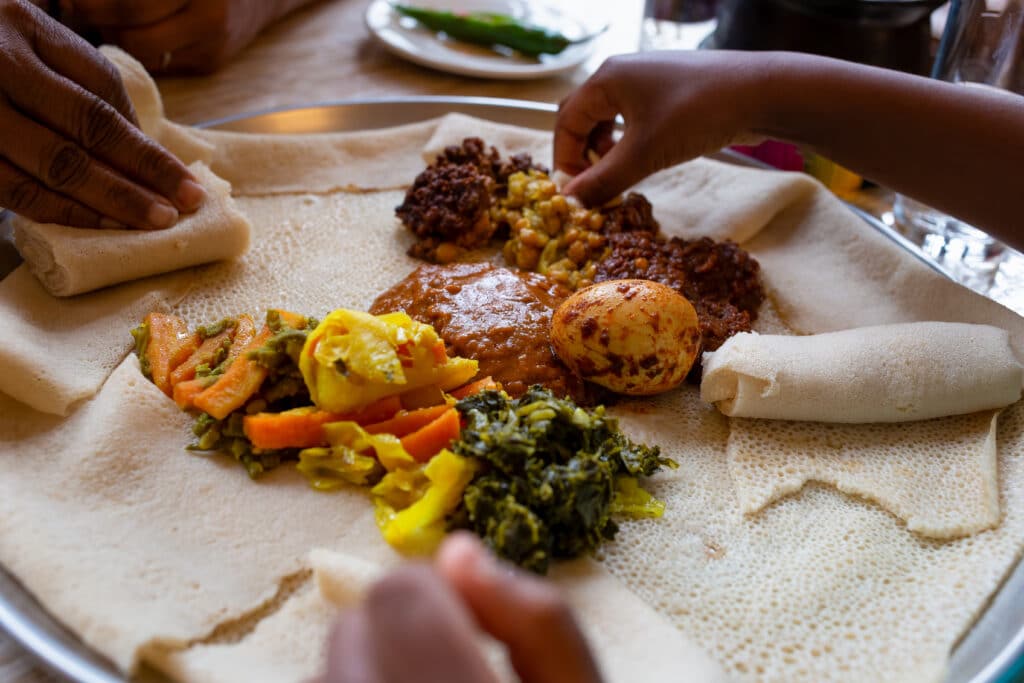
In the heart of East Africa, Ethiopian and Eritrean cuisines introduce a sourdough flatbread that’s more than just a side dish: injera. With its spongy texture and sour taste, it’s an essential part of Ethiopian food.
Injera is an essential component of traditional Ethiopian celebrations and festivals. It is often served during Orthodox Christian holidays, weddings, and other special occasions.
Our team at Remitly created this guide as part of our series that celebrates the traditional dishes of our global customers.
What is Injera?
Injera is a type of Ethiopian flatbread with a crepe or pancake-like consistency. It’s made primarily from teff flour, which is gluten-free and rich in carbohydrates, calcium, and potassium.
Teff injera has garnered attention not just in Ethiopia and Eritrea but also in vegan communities worldwide because of its nutritious content.
The Art of Making Injera
Ingredients:
- Cups teff flour: 2
- Cups water: 3
- Baking soda: 1/2 teaspoon
- Salt to taste
- Optional: All-purpose flour or wheat flour for a different variation
Instructions:
- Prep Time: Start by combining the teff flour and water in a large bowl. Mix them thoroughly until you have a smooth injera batter.
- Fermenting: Cover the bowl with plastic wrap and let it ferment at room temperature. This fermenting process gives injera its distinct sourdough flavor. It’s crucial to let it sit for 1-3 days, depending on your desired sourness.
- Cook Time: When ready to cook, heat a non-stick pan or non-stick skillet on medium heat. If you’re using a traditional Ethiopian mitad (griddle), heat it on high heat.
- Using a measuring cup, pour a cup of the batter onto the center of the griddle or skillet. Quickly swirl the pan to spread the batter into a thin circle, much like how you’d make a crepe.
- Cover the pan and let it cook until bubbles form and the edges begin to lift. Do not flip the injera.
- Once cooked, transfer the injera to a plate and cover with a paper towel to keep it moist.
- Repeat with the rest of the batter.
Serving Injera
Serve your injera with side dishes like doro wat, lentils, or gomen. The first time you make injera, it might not be perfect, but practice makes perfect. If you don’t have the time to make it, you might find pre-made injera at an Ethiopian restaurant or even on Amazon.
Total Time: Prep time plus 3-7 minutes per injera, plus fermenting time.
Additional Notes:
- If your injera isn’t sour enough, you can experiment by adding a bit of sourdough starter to the batter.
- For those without access to teff flour, a mix of all-purpose flour and sourdough starter can also yield an injera-like flatbread.
- Traditionally, injera is also a dish in Eritrea, and there might be slight variations in the Eritrean injera recipe.
- If you don’t have teff flour, some Ethiopian restaurants or specialty stores might offer it.
Teff: The Gluten-Free Superfood
Teff is a tiny grain that is native to Ethiopia and is the primary ingredient in injera. It is a gluten-free grain that is packed with nutrients, making it a popular choice for those who follow a gluten-free diet. Teff is rich in protein, fiber, and a variety of vitamins and minerals.
Teff flour is used to make the batter for traditional injera.
Learn More About Ethiopian Cuisine
One of the most distinctive aspects of Ethiopian cuisine is the use of spices and herbs. Ethiopian dishes are known for their bold and complex flavors, which are achieved through the careful blending of spices such as berbere, a fiery spice blend made from chili peppers, garlic, ginger, and a variety of other spices. This blend of spices has influenced the cuisines all over the region and can be found in traditional dishes of Burundi, Eritrea, and all over the horn of Africa.
In addition to spices, Ethiopian cuisine also features a wide variety of vegetables, legumes, and grains. Lentils, chickpeas, and split peas are commonly used in stews and curries, while vegetables like cabbage, carrots, and potatoes are often included.
Grains such as barley, wheat, and millet are also staples in Ethiopian cuisine, used to make breads, porridge, and other traditional dishes. Well-known Ethiopian recipes include:
- Doro Wat
- A spicy chicken stew seasoned with berbere spice and served with hard-boiled eggs.
- Kitfo
- Minced raw beef seasoned with mitmita (a spicy chili powder) and niter kibbeh (spiced clarified butter).
- Shiro Wat
- A stew made from ground chickpeas or broad bean flour.
- Tibs
- Sautéed or grilled meat, typically served with vegetables.
- Firfir
- Torn pieces of injera soaked in spicy berbere sauce, often combined with other ingredients.
- Beyainatu
- A vegetarian combo platter consisting of various vegetable and lentil stews served on injera.
- Alicha Wat
- A milder stew made without berbere, often featuring vegetables, lentils, or meat.
- Kik Alicha
- A yellow split pea stew seasoned with turmeric.
- Gomen
- A dish made from collard greens sautéed with spices and niter kibbeh.
- Misir Wat
- A spicy red lentil stew seasoned with berbere.
Visit the homepage, download our app, or check out our Help Center to get started.